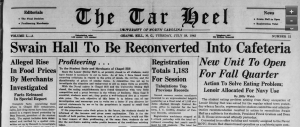
“Swain Hall To Be Reconverted Into Cafeteria.” Digital image. The Tar Heel. Accessed November 5, 2018. Newspapers.com https://universityofnorthcarolinaatchapelhill.newspapers.com/image/67903999/ Full page: The_Daily_Tar_Heel_Tue__Jul_28__1942_ (1) .
“Swain Hall To Be Reconverted Into Cafeteria” headlined The Tar Heel’s front page on July 28, 1942. The collection of headlines and sub-headings, visible in source above, summarize aspects of the socioeconomic scene at the time, speaking directly to the Chapel Hill food story during World War II. During this time of war, the U.S. Government mandated civilian rationing of food and gasoline in order to sufficiently supply and support American soldiers.[1] The daily rituals and routines of Americans across the country subsequently changed due to mandatory rationing. This source specifically points to other events related to the war that influenced local consumption in addition to the limitation of national rationing during this time, such as the University’s allocation of Lenoir Dining Hall for Naval use. [2] This is one of the specific local events displayed in this source that gives insight to the role food played during this time in history.

“Profiteering.” Digital image. The Tar Heel. Accessed November 5, 2018. Newspapers.com https://universityofnorthcarolinaatchapelhill.newspapers.com/image/
The main headline, as discussed above, notified locals that the former dining hall, Swain Hall, that was closed when Lenoir was built in 1940, would reopen to meet the needs of students, and solve the “Eating Problem,” produced by the Navy’s complete occupation of Lenoir Hall[3]. While this is the main headline of the newspaper, it serves as background information to preface the section titled “Profiteering,” (also on the front page) which is a letter addressed to the student body and local merchants of Chapel Hill written by the student body president at the time, Bert Bennett. In the letter, Bennett addresses the issue of local merchants increasing food prices, which is upheld by the column headline on the far left of the front page as well (see” Alleged Rise in Food Prices By Merchants Investigated”). Bennett writes that he will publish a notice in the paper of establishments that have raised prices without explanation and asks that the merchants, “not take advantage of students by unnecessarily raising prices, particularly food prices.” [4].
This section is of particular interest to me because I believe that it connects serval local events that affect the food story of Chapel Hill during wartime. While Lenoir Hall closed to the public, students ventured to local merchants for food, and thus certain local food merchants increased prices knowing the demand for food on campus. By this connection, the sections, “Swain Hall To Be Reconverted Into Cafeteria,” “Profiteering,” and “Alleged Rise in Food Prices By Merchants Investigated,” from this front page collectively display a part of the unique food story of Chapel Hill during wartime, as they connect the action of the University to allocate dining space to the Navy, to the repercussions of that action in the local community, and the effect it had on the student body at the time.
[1] Jennifer Wallach & Lindsey Swindall. American Appetites. Fayetteville: The University of Arkansas Press, 2014.
[2] Billy Webb. “Swain Hall To Be Reconverted Into Cafeteria” The Tar Heel,
July 28, 1942, https://universityofnorthcarolinaatchapelhill.newspapers.com/image/67903999/.
[3] Webb. “Swain Hall To Be Reconverted Into Cafeteria”
[4] Bert Bennett “Profiteering…” The Tar Heel,
July 28, 1942, https://universityofnorthcarolinaatchapelhill.newspapers.com/image/67903999/.
Natalie Huggins